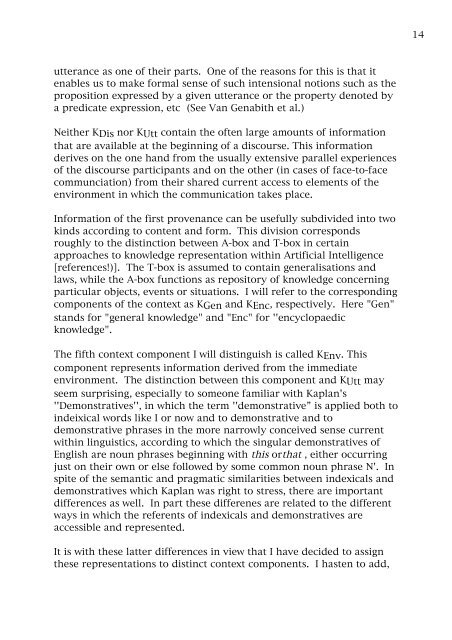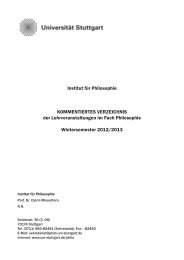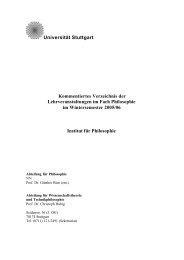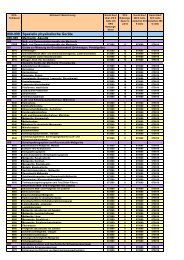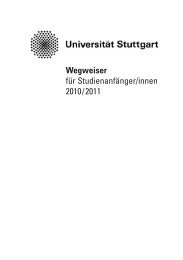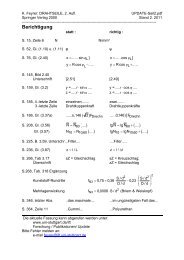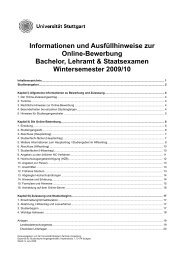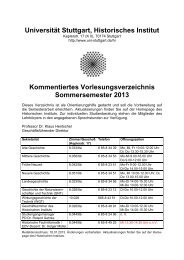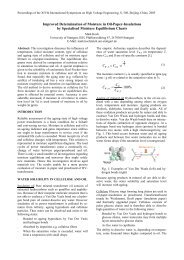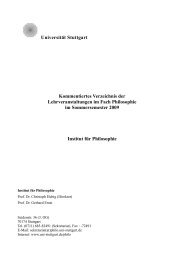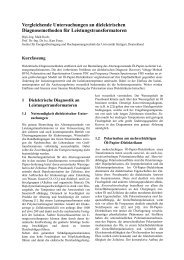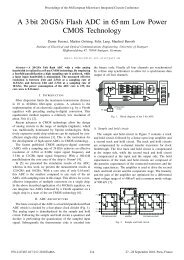Discourse Structure and the Structure of Context - Multiple Choices
Discourse Structure and the Structure of Context - Multiple Choices
Discourse Structure and the Structure of Context - Multiple Choices
You also want an ePaper? Increase the reach of your titles
YUMPU automatically turns print PDFs into web optimized ePapers that Google loves.
14<br />
utterance as one <strong>of</strong> <strong>the</strong>ir parts. One <strong>of</strong> <strong>the</strong> reasons for this is that it<br />
enables us to make formal sense <strong>of</strong> such intensional notions such as <strong>the</strong><br />
proposition expressed by a given utterance or <strong>the</strong> property denoted by<br />
a predicate expression, etc (See Van Genabith et al.)<br />
Nei<strong>the</strong>r KDis nor KUtt contain <strong>the</strong> <strong>of</strong>ten large amounts <strong>of</strong> information<br />
that are available at <strong>the</strong> beginning <strong>of</strong> a discourse. This information<br />
derives on <strong>the</strong> one h<strong>and</strong> from <strong>the</strong> usually extensive parallel experiences<br />
<strong>of</strong> <strong>the</strong> discourse participants <strong>and</strong> on <strong>the</strong> o<strong>the</strong>r (in cases <strong>of</strong> face-to-face<br />
communciation) from <strong>the</strong>ir shared current access to elements <strong>of</strong> <strong>the</strong><br />
environment in which <strong>the</strong> communication takes place.<br />
Information <strong>of</strong> <strong>the</strong> first provenance can be usefully subdivided into two<br />
kinds according to content <strong>and</strong> form. This division corresponds<br />
roughly to <strong>the</strong> distinction between A-box <strong>and</strong> T-box in certain<br />
approaches to knowledge representation within Artificial Intelligence<br />
[references!)]. The T-box is assumed to contain generalisations <strong>and</strong><br />
laws, while <strong>the</strong> A-box functions as repository <strong>of</strong> knowledge concerning<br />
particular objects, events or situations. I will refer to <strong>the</strong> corresponding<br />
components <strong>of</strong> <strong>the</strong> context as KGen <strong>and</strong> KEnc, respectively. Here "Gen"<br />
st<strong>and</strong>s for "general knowledge" <strong>and</strong> "Enc" for ''encyclopaedic<br />
knowledge".<br />
The fifth context component I will distinguish is called KEnv. This<br />
component represents information derived from <strong>the</strong> immediate<br />
environment. The distinction between this component <strong>and</strong> KUtt may<br />
seem surprising, especially to someone familiar with Kaplan's<br />
''Demonstratives'', in which <strong>the</strong> term ''demonstrative” is applied both to<br />
indeixical words like I or now <strong>and</strong> to demonstrative <strong>and</strong> to<br />
demonstrative phrases in <strong>the</strong> more narrowly conceived sense current<br />
within linguistics, according to which <strong>the</strong> singular demonstratives <strong>of</strong><br />
English are noun phrases beginning with this orthat , ei<strong>the</strong>r occurring<br />
just on <strong>the</strong>ir own or else followed by some common noun phrase N'. In<br />
spite <strong>of</strong> <strong>the</strong> semantic <strong>and</strong> pragmatic similarities between indexicals <strong>and</strong><br />
demonstratives which Kaplan was right to stress, <strong>the</strong>re are important<br />
differences as well. In part <strong>the</strong>se differenes are related to <strong>the</strong> different<br />
ways in which <strong>the</strong> referents <strong>of</strong> indexicals <strong>and</strong> demonstratives are<br />
accessible <strong>and</strong> represented.<br />
It is with <strong>the</strong>se latter differences in view that I have decided to assign<br />
<strong>the</strong>se representations to distinct context components. I hasten to add,


